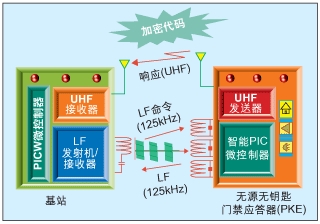Global automotive semiconductors face enormous market opportunities, but design engineers also face technical challenges in terms of cost, power consumption, and security. This article takes the latest intelligent transponders that can receive and send data as an example to introduce to Chinese automotive design engineers the technical methods to solve these challenges in the design of automotive wireless access systems.
This article refers to the address: http://
In China, the semiconductors used in the safety and confidentiality electronic control module account for about half of China's automotive semiconductors. From the remote keyless gated applications already in use to emerging applications such as passive keyless door (PKE) systems, tire pressure monitoring systems, electronic payment (charge) and Bluetooth hands-free systems, wireless systems are constantly being used in vehicles. Emerging in the middle. These wireless connections are a technical means of improving the performance of security and privacy modules and are building the features that drivers desire. The emergence of other dedicated short-range wireless communication solutions for security and privacy applications is limited only by the availability of cost-effective technologies. In addition to the traditional pressure to reduce time to market and increase functionality, design engineers face the challenges of cost-effective performance enhancements, power consumption, small size, and cryptographic security.

Table 1: Main technical difficulties and solutions for PKE smart transponders.
For example, let's take a look at a wireless system that represents the many challenges faced by today's system architects—the latest intelligent transponders that can receive and send data. In this two-way communication system, the base station and the transponder can automatically communicate without human intervention. This low-cost, two-way communication transponder can be designed to operate with two frequencies: 125 kHz for receiving data and UHF (315, 433, 868 or 915 MHz) for transmitting data. Due to the non-propagating nature of the 125 kHz signal, the two-way communication distance is typically no more than 3 meters. Since the transponder also has buttons for performing optional operations, a longer one-way transmission distance (from the transponder to the base station) can be supported when the transmit button is pressed.
In these applications, the base station transmits commands at a frequency of 125 kHz while waiting for nearby valid transponders to send back responses at UHF frequencies. The smart transponder is typically in receive mode and waits for any valid 125 kHz base station command. If any valid base station command is received, the transponder sends a response at UHF frequency. This is what we call "passive keyless door control system." Because the PKE system uses a 125 kHz circuit for bidirectional communication, low-cost, small-volume, and low-power PKE transponders can be produced using an integrated system-on-chip (SoC) intelligent microcontroller unit (MCU) with digital and low-frequency front ends.
PKE system challenge
As design engineers gain more system experience, they are increasingly faced with the challenge of reliably designing the PKE transponder functionality to make it a cost-effective alternative to traditional PKE transponders while ensuring that it meets specific systems. aims. Table 1 lists some of the main concerns and solutions faced by system design engineers. Although PKE transponders seem to need to be implemented with complex and expensive circuitry, the challenges faced by design engineers have been met by using some relatively simple, around a smart PIC-type microcontroller (PIC16F639) that includes all the necessary features to meet A low-cost circuit required for secure two-way communication is addressed.
Figure 1 shows an intelligent PKE system. It also has buttons for optional operations, but the main operations can be done without any manual intervention. The two-way communication sequence of the PKE application is as follows: the base station transmits the command with a frequency of 125 KHz; the transponder receives the 125 KHz base station command with three orthogonal LC resonant antennas; if the command is valid, the responder sends a response (encrypted data) through a UHF transmitter; If the data is correct, the base station receives the response and activates the switch.

Figure 1: Intelligent Passive Keyless Gating (PKE) System with Two-Way Communication
One of the challenges faced by design engineers is the cost-effective implementation of system performance enhancements including communication distance, antenna directivity, small package size, encryption security, and low power consumption under door lock "on/off" conditions. A transponder design that reliably accepts base station commands within the 125 kHz signal range and maintains long battery operating time meets critical system enhancement requirements.
Input sensitivity requirements for two-way communication distance
In battery-powered transponder applications, the maximum communication distance with UHF (315/433/915 MHz) is approximately 100 meters, but with low frequencies (LF, 125 kHz) it is only a few meters of communication distance. Therefore, the communication distance of the dual-frequency PKE transponder is mainly limited by the commanded distance of the 125 kHz base station. Due to the non-propagating nature of the low frequency signal, the 125 kHz signal will decay rapidly as the distance increases. For example, assuming that the base station outputs an antenna output voltage of about 300 Vpp, the voltage induced by the coil antenna of the transponder at a distance of about 3 meters is only about 3 mVpp, which is equivalent to the noise level of the application environment. Therefore, how to effectively detect weak signals is a major problem faced by system design engineers.
To increase the range of the 125 kHz base station command, two possible solutions are considered: (a) increasing the transmit power of the base station transmitter; and (b) increasing the input sensitivity of the transponder. The maximum transmit power of the base station transmitter is generally limited by the government. Therefore, the second method for improving the sensitivity of the input signal detection is the only effective solution, assuming that the maximum power transmitted by the base station is within the allowable range. In order to achieve a two-way communication distance of 3 meters, the transponder input sensitivity must be around 3 mVpp.
Constant Voltage 48V Aluminum Waterproof Led Driver
Designed for Aluminum Waterproof Led Driver IP65 OR IP67, output DC 48V Constant Current Led Driver, low voltage output, high security, easy installation, are generally aluminum, is the market common products, use a wide range, High water level is used for outdoor use. Fahold Waterproof Driver , frameless Aluminum Profile Led Driver, Driver Pwm 5000Ma . Adjustable Led Driver , 48V Constant Voltage Driver, Dimmable Led Driver 48V
Features
Input voltage: 100-277vac
output voltage: 48vdc
current: 1600mA/2000mA/3100mA.
Power factor: >0.95
Dimming:0-10V / PWM / RX
Flicker free output.
IP67 waterproof
>=50000hours, 5 years warranty.
certificate: UL CE FCC TUV SAA ect.

Applications
- Street lights.
- Swimming pool lights
-
High bay lights
Constant Voltage 48V Aluminum Waterproof LED Driver
Adjustable Led Driver,48V Constant Voltage Driver,Dimmable Led Driver 48V
ShenZhen Fahold Electronic Limited , https://www.fahold.com